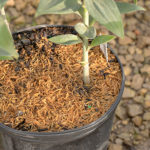What’s that in our pots? Rice?

You may nave noticed something different in our perennial pots recently. Covering the soil of some of the varieties we grow are tiny rice hulls. Sounds delicious, right? No, it's not the starchy side dish.
Rice hulls are a sustainable soil amendment with many advantages. Here at Christensen’s Plant Center rice hulls are used mostly as a top dress to prevent weeds. Our perennial production department applies them at the time of potting. Used properly, they can help control a weed problem before it even begins. If you can manage to get more rice hulls in the pot than on your person, these can be very effective.

Rice hulls can also be used in the landscape. Mixed into the top 6-12” of your garden or planting beds, the advantages include better drainage, water holding capacity, and soil aeration. And for all of you environmentalists out there, rice hulls are 100% organic and biodegradable.
As a top dress, rice hulls are great for holding moisture and preventing weeds, but there are a few downsides. THOSE THINGS ARE A MESS! Once you open up the bale, you will find it in every pocket and every shoe of those around it. Also not the best thing to use on a windy day... We've found that the most effective plants to use it on have been hosta and daylily.

Sometimes the rice hulls work a little TOO well. With plants that cannot handle a wet crown, rice hulls should not be used. Since rice hulls are to be applied ½-1” thick, that can be too much moisture. For plants like sedum, rice hulls are not recommended.

Rice hulls are a cost effective, easy way to maintain plant moisture and keep away weeds. Just not the best to have for lunch.

